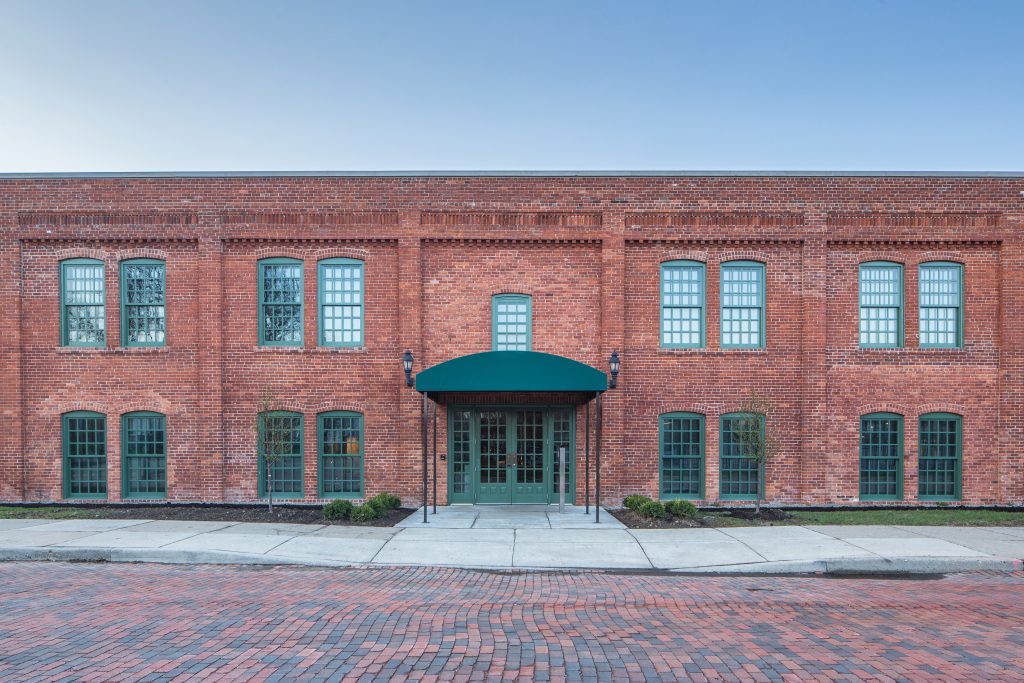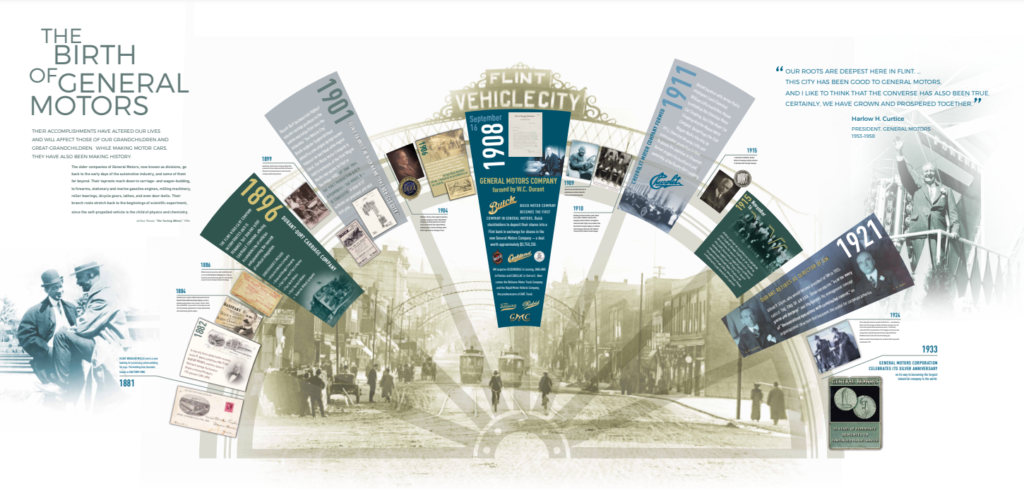General Motors HISTORY
1876 – 1899
1876 The United States celebrates our nation’s centennial
1878 Robert McLaughlin begins carriage manufacturing operations in Oshawa, Ontario
1879 David Dunbar Buick becomes a supervisor of the brass finishing department at Flower and Brothers in Detroit. For a brief time, sixteen-year-old Henry Ford was employed milling brass valves at Flower’s company, so likely worked under Buick’s supervision.
1881 The Flint Woolen Mills erects a new building for the processing of cotton webbing for rugs. The building later became known as Factory One.
1882 The Flint Wagon Works is established by Josiah W. Begole, Michigan’s 19th Governor (1883-1885). As a partner in the Begole & Fox lumber mill, he sought to diversify business as Flint’s lumber economy faded and turned to manufacturing farm wagons. Begole hires James H. Whiting to manage the business.
1884 The Flint Wagon Works becomes the first incorporated business in Flint
1884 David Buick joins coworker William Sherwood to form the Buick & Sherwood Manufacturing Company, producing plumbing supply products such as valves, faucets, toilets, tanks, and bathtubs.
1886 William Crapo Durant partnered with Josiah Dallas Dort forming the Flint Road Cart Company after acquiring the patent and manufacturing rights for a two-wheeled road cart from the Coldwater Road Cart Company
1890 Henry M. Leland moves to Detroit and establishes the Leland, Faulconer & Norton Company, manufacturer of machine tools, grinders, gear cutters, etc.
1890 Ransom E. Olds established the Olds Gasoline Engine Works in Lansing, MI.
1892 Durant and Dort establish the Webster Vehicle Company as a subsidiary to produce light spring wagons (Thomas Webster, VP & GM)
1892 The Duryea brothers successfully build and operate the first gasoline car built in America
1893-November Pontiac Buggy Company is organized by Edward N. Murphy, S. E. Beach, and Francis Emmendorf. Murphy becomes sole owner in 1904.
1894 Durant and Dort establish the Victoria Vehicle Company as a subsidiary to produce farm wagons (George C. Wilson, VP & GM)
1894 The Detroit Tigers are organized and play in the Western League.
1895 David Buick leverages the proceeds from the plumbing supply business to begin experimenting with and producing gasoline engines.
1896 The Flint Road Cart Company incorporates and is renamed the Durant-Dort Carriage Company
1896 Durant-Dort establishes the Diamond Buggy Company as a subsidiary to produce low-cost buggies (A.B.C. Hardy, VP & GM)
1897 Durant-Dort establishes the Flint Gear and Top Company as a subsidiary to produce carriage tops and accessories (George C. Wilson, VP & GM)
1897 The Buick & Sherwood baseball team captures the Detroit amateur team championship
1897 Olds Motor Vehicle Company is organized, and the first Oldsmobile produced
1898 B. C. Hardy named president of the Durant-Dort Carriage Company following a personal leave of absence by J. Dallas Dort
1898 Durant-Dort purchases the Imperial Wheel Company in Jackson, MI (W.C. Orrell, VP; C. B. Hayes, GM)
1899 Buick, with the help of employee Walter Marr, produces his first prototype automobile and, with partner Sherwood, announces plans to enter the motor carriage manufacturing business.
1899 The Buick & Sherwood Manufacturing Company is merged with eight other companies into the largest plumbing supply consortium in the country, referred to as the bathtub trust, but carrying the name Standard Sanitary Manufacturing Company. Headquartered in Pittsburgh, PA, both Buick and Sherwood sell their shares in the business by early 1902. The company is known today as American-Standard.
1899 David Buick forms the Buick Auto Vim and Power Company, located in the Boydell Building on Beaubien Street in Detroit (still standing in Greektown).
1899 In order to obtain financial backing, Ransom Olds moves his factory from Lansing to Detroit, in what is the first factory built exclusively for automobile production. The factory is destroyed by fire in March 1901.)
1900 – 1910
1900 A new industrial park is developed on Flint’s north end named Oak Park Industries. It becomes home to new factories for the Armstrong Spring Company and Stewart Body Company
1900 J. Dallas Dort returns to Flint and resumes his former duties at the Durant-Dort company
1900 Durant-Dort establishes the Flint Axle Works and locates in Flint’s Oak Park development (Fred Weiss, VP & GM)
1901 Durant-Dort establishes the Flint Varnish Works and locates in Flint’s Oak Park development C. W. Nash, VP; W.W. Mountain, GM)
1901 Durant-Dort constructs a new plant for the Imperial Wheel Company in Flint located in Flint’s Oak Park development (C.B. Hayes, VP and GM)
1901 Flint earns the nickname “The Vehicle City” and Durant-Dort becomes the highest volume carriage producer in the nation
1901 Leland and Faulconer is contracted to produce 2000 motors for Olds Motor Works
1901 The curved dash Oldsmobile runabout became the first American car to be manufactured in quantity.
1901-November-29 Buick engineer Eugene Richard files a patent for what is arguably the first design that encompassed the elements for what is today known as the overhead valve (ohv) engine. Buick would later market it as “valve-in-head.”
1902 David Buick formed the Buick Manufacturing Company in Detroit, beginning in a garage behind his home on Meldrum Avenue in Detroit and soon moved to a more appropriate building on Detroit’s west side.
1902-August-22 Cadillac Automobile Company is organized when Henry Leland, of Detroit’s Leland and Faulconer Company, is asked by investors in the Detroit Automobile Company (Henry Ford’s second failed attempt at automobile manufacturing) to value the assets of the company for liquidation. Leland instead proposes that the business be salvaged and names the new vehicle Cadillac.
1902 A. B. C. Hardy resigns from Durant-Dort to organize the Flint Automobile Company, becoming the city’s first automobile manufacturer
1903-March First Cadillac Model A is completed
1903-May-19 The Buick Motor Company is incorporated in Detroit. With a backlog of orders for stationary engines and a second completed automobile, David Buick needs cash to expand but is unsuccessful finding investors in Detroit.
1903-September-03 The Buick Motor Company is sold to investors at the Flint Wagon Works and, after a new factory was constructed, moved to Flint in December 1903.
1904-January-24 The second Buick automobile was registered in Detroit as a “Bewick” and assigned license number 365.
1904-June The first 1904 Buick Model B, the first production Buick automobile, is completed. A total of 37 vehicles are produced and sold that year
1904-November-01 William C. Durant, at the request of investors, assumes managerial control of Buick Motor Company. Assembly operations are moved to the vacant Durant-Dort Imperial Wheel Company plant in Jackson, MI, which Buick acquires for an exchange of stock.
1904-Nov-26 Charles M. Begole named president of Buick Motor Company
1906 Buick constructs a mammoth new factory on Flint’s north end on property acquired from Durant-Dort.
1906 Other C. S. Mott’s Weston-Mott Company moves from Utica, NY, to a new factory in Flint next to the new Buick factory
1907-August-28 Oakland Motor Car Company organized in Pontiac by E. N. Murphy and eventually acquired all Pontiac Buggy Company plants.
1908 Fisher Body Company organized
1908 Buick was the No. 1 producer of automobiles in the country, surpassing the combined total of its closest two competitors, Cadillac and Ford.
1908 Albert Champion forms the Champion Ignition Company in a corner of the Buick Factory. Its name is later changed to A.C. Spark Plug.
1908 Alanson Brush, friend of David Buick and designer of the Cadillac engine, becomes consulting engineer for Oakland.
1908 Cadillac won the Dewar Trophy in London for demonstrating interchangeability of parts, a basic element of mass production
1908-September-16 General Motors Company is organized by William Crapo Durant.
1908-September-29 Buick Motor Company becomes the first company in General Motors and is used as its financial base by asking Buick stockholders to deposit their shares into a Flint bank in exchange for shares in the new General Motors Company, a deal worth approximately $3,750,250.
1908-October GM acquires Oldsmobile in Lansing largely through stock exchange
1909-January-08 GM acquired Oakland in Pontiac for just over $200,000.
1909-July-27 GM acquired Cadillac in Detroit for $4,500,000, the largest transaction ever recorded in Detroit at that time. (Because of the large amount of cash involved, Buick purchased Cadillac for the parent company and transferred ownership shortly thereafter)
1909 GM acquired the Reliance Motor Truck Company of Owosso, MI, and the Rapid Motor Vehicle Company of Pontiac, MI, the predecessors of GMC Truck
1909-March Louis Chevrolet joins Bob Burman, Lewis Strang, and others on Buick’s factory sponsored racing team.
1909-October-26 Durant gains board approval to purchase Ford Motor Company for an agreed upon price of $8,000,000 but was then told by bankers who had agreed to the loan that “We have changed our minds. The Ford business is not worth that much money.”
1910 The Flint Wagon Works begins production of the Whiting Automobile in Flint
1910 A financial panic leads to a call on GM’s outstanding debt which brings manufacturing to a halt. Durant assembled an equity package worth $21.6 million in return for a loan of $12.25 million to get plants up and production again and prevent GM from going into receivership.
1910-November-11 Durant loses control of GM but remains on the company’s board of directors.
1910 Charles W. Nash, vice president of the Durant-Dort Carriage Company, appointed to run Buick Motor Company at the suggestion of Durant
1911 – 1920
1911 Bob Burman sets a new land speed record at Jacksonville, FL, driving a Buick “Bug” – 20 miles in 13 minutes 11.92 seconds (~91 mph)
1911 Durant-Dort establishes the Flint Motor Wagon department and goes into production of light duty trucks under the “Flint” and “Best” marques
1911 Walter P. Chrysler is hired as Buick’s works manager
1911 Durant purchases the Flint Wagon Works from James H. Whiting
1911 Durant and former Buick works manager William H. Little establish the Little Motor Company to build automobiles at the Flint Wagon Works site.
1911 After the new GM managers withdrawal from factory sponsored automobile racing, Durant and former Buick race car driver Louis Chevrolet form the Chevrolet Motor Company to build automobiles
1911 Durant and former Buick engine superintendent Arthur Mason establish the Mason Motor Company to produce engines for both Little and Chevrolet carlines
1912 Charles M. Begole, former Flint Wagon Works and Buick executive, named president of Chevrolet Motor Company
1912 C. F. Kettering invents the electric starter which goes into production on Cadillac, followed by Buick in 1913.
1912 Chevrolet acquires the factory of the Imperial Wheel Company in Flint when that company’s operations are moved to the former Webster Vehicle plant near downtown Flint
1912 Chevrolet absorbs Little and concentrates production in Flint in 1913
1912 Flint Axle Works sold by DDCC and renamed Walker-Weiss Axle Company
1913-August-07 W. C. Durant resigns from the carriage company he co-founded 27 years prior with J. D. Dort
1913-November-18 C. W. Nash, former cushion stuffer with the Flint Road Cart Co., named president of GM
1913 C. S. Mott joins the GM Board of Directors and continues to serve until his death in 1973
1915 J. D. Dort establishes the Dort Motor Car Company, using the factories of the Durant-Dort Carriage Company
1915-September-23 Chevrolet Motor Company is incorporated in Delaware to acquire the stock of the various Chevrolet operations across the U.S. and Canada.
1915 A. B. C. Hardy named vice president of Chevrolet
1915-November-16 in what can only be described as a board room coup, Durant regains control of GM. By trading five shares of Chevrolet stock for one share of GM stock and through proxy, Durant controls roughly 55% of outstanding shares of GM stock.
1916-June-01 W. C. Durant named president of GM after the resignation of C. W. Nash
1916-October-13 General Motors Corporation organized under Delaware law to acquire all stock of the General Motors Company.
1916-December-14 Walter P. Chrysler named president of Buick and a GM vice-president.
1916 United Motors Corporation organized
1916-December GM subsidiaries set up as “Divisions” (i.e. Buick Motor Company became Buick Motor Division)
1916 Former Durant-Dort, Buick, and GM executive Charles Nash purchases the Jeffrey Company of Kenosha, WI, and renames it the Nash Motor Company
1918-May-02 General Motors Corporation purchases Chevrolet Motor Company.
1918 Flint Varnish & Color Works purchased by E. I. DuPont de Nemours Co.
1918 A. B. C. Hardy named assistant to the president of GM
1918 General Motors completes acquisition of United Motors, McLaughlin Motor Car Co., and Chevrolet of Canada.
1919 the Guardian Frigerator Company was acquired by GM and renamed Frigidaire.
1919-June-02 Ground is broken on GM’s new Detroit headquarters, to be named “The Durant Building.” Ornamental “D” stonework can still be seen in the building’s exterior, and it doesn’t stand for “Detroit.” It should be noted that Durant himself opposed spending money on an office building, preferring to use the funds for products, but was outnumbered in the vote.
1919 General Motors Institute of Technology (now Kettering University) opens in Flint with 300 students in a former Durant-Dort factory
1920 C. F. Ketteringestablished the General Motors Research Corporation (later renamed General Motors Research Laboratories), the auto industry’s first full-time in-house research center.
1920 Walter P. Chrysler resigns from Buick and General Motors
1921 – 1930
1921 Durant resigned from and retired as a director of GM. Alfred P. Sloan calls it the end of an era.
1921-January GM’s world headquarters, renamed the “General Motors Building,” is completed
1921-May-21 A. B. C. Hardy named president and general manager of Oldsmobile
1922 Imperial Wheel Company is acquired by its former manager, C. B. Hayes, owner of the Hayes Wheel Company which also later acquires the Kelsey Wheel Company to form the Kelsey-Hayes Wheel Company.
1923 Alfred P. Sloan, Jr. became president of GM
1924 The Dort Motor Car Company ends production, bringing an end to personal transportation manufacturing at the factories along South Street (W. Water Street) in Flint
1924 General Motors Proving Ground, Milford, MI, established.
1924 Armstrong Spring Company becomes a division of General Motors
1924 Buick introduced four-wheel brakes
1925-May-17 Josiah Dallas Dort dies of a heart attack on the golf course at the Flint Country Club
1925 Alfred Sloan implemented his management concept of “decentralized operations with coordinated control,” an organizational structure which became the model for corporate America, copied not only by large and small corporations alike but government agencies and even non-profit organizations.
1925 Yellow Truck & Coach Manufacturing Company established and assumes control of General Motors Truck (GMC)
1926 Ownership of Fisher Body Corporation completed by General Motors
1926 the Pontiac car was introduced by Oakland Division
1927 Albert Champion dies in Paris, France
1929 Frigidaire produces the first room air conditioning system
1929 David D. Buick dies, in obscurity and poverty, in Detroit, Michigan.
1931 – 1940
1932 Armstrong Spring Division of General Motors is absorbed by Buick Motor Division.
1933 Individual front wheel suspension, called “knee action,” developed by GM Engineering Staff
1936 The Detroit Red Wings won their first Stanley Cup
1937-February-11The conclusion of a forty-four day sit-down strike in Flint against General Motors led to GM becoming the first company to recognize the United Automobile Workers of America (UAW).
1939 The first turn signals in the automotive industry are developed by Guide Division and introduced by Buick.
1940-January-11 on the brink of World War II, GM produced its 25,000,000th car
Contributions to this site by...
BIG thank you to General Motors, Factory One and especially Kevin Kirbitz, Director of the Heritage Operations with General Motors. Kevin worked hard on this timeline to be as accurate as possible, without leaving anything significate out.
For corrections, additions or questions, email Executive Director Amber Taylor ambertaylor@backtothebricks.org




